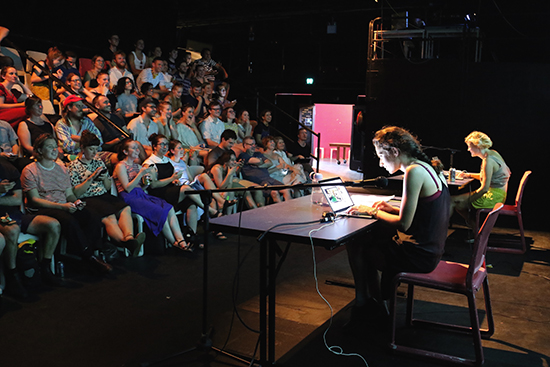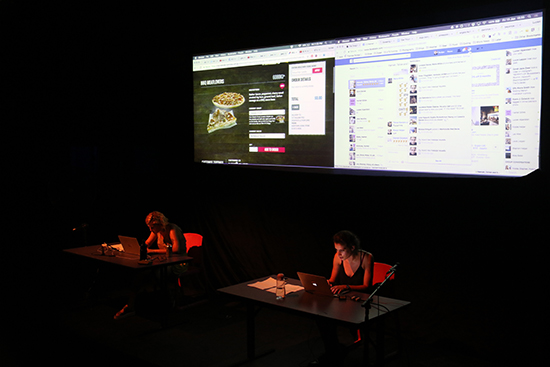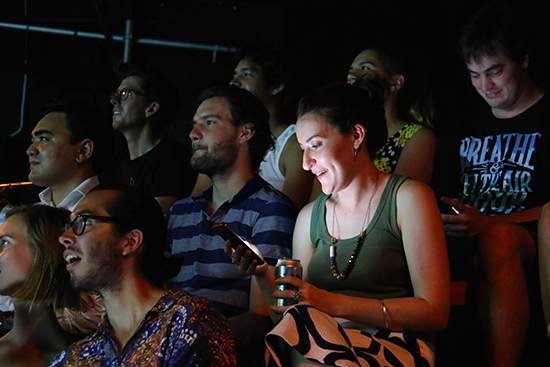Into the internet’s black holes
Lauren Carroll Harris, zin, The internet is where innocence goes to die and you can come too

The internet is where innocence goes to die and you can come too, zin, PACT Centre for Emerging Artists
photo Carla Zimbler
The internet is where innocence goes to die and you can come too, zin, PACT Centre for Emerging Artists
So much art today is made of the internet. Richard Prince recycles Instagram shots. Michael Manning uses Microsoft Paint to make work in a Windows 95 aesthetic. Lorna Mills puts together outdoor installations of animated gifs. But how do you make a live art show about the process of surfing the net?
Using a Facebook group chat as the structure for engaging audiences and presenting the work, it seems. The internet is where innocence goes to die and you can come too is the newest work by performance art duo zin, and it does just that, drawing audiences over the course of an hour down a series of Internet black-holes. Artists Roslyn Helper and Harriet Gillies sit at two tables onstage, the contents of their laptop screens projected behind them. After inviting the audience into a group chat, the artists ask a series of questions and the answers become the show’s substance: what song should we play next? Cher’s “Believe”? Who wants pizza? Who’s vegetarian; garlic bread, too? From the big screens to our iPhones, the group chat explodes. One participant is Tindering as the show goes on and posts screenshots of chats with prospective dates. Cher photos fly around everywhere.
The next batch of questions provide fuel for a trail of Google searches. Who’s your favourite internet celebrity? What’s your favourite place on the internet? Eventually, the trail leads Gillies to enquire about buying a gun and Helper to look up and comment in Spanish on Natalie Portman porn. Meanwhile, the pizza order provides an arc for the show to follow: on the big screen, we intermittently see the progress of Domino’s GPS-enabled order tracker. The show ends with a bewildered delivery guy called Sampath Kumar bringing our pizzas to the front of the theatre to great applause, and Helper and Gillies taking a big theatre-wide selfie with the audience, promptly posted to the FB chat.

The internet is where innocence goes to die and you can come too, zin, PACT Centre for Emerging Artists
photo Carla Zimbler
The internet is where innocence goes to die and you can come too, zin, PACT Centre for Emerging Artists
Initially developed by Kaldor Public Art Projects during the duo’s 2015 residency with performance artist Marina Abramovic, the show has the aesthetics of any internet artwork you can think of (like the kitsch slideshows of Jennifer Chan), but the sensibility of pop art: half-ironic, half-celebratory and coming from a place of immersion in mass culture.
What was the task of the work, what was it doing? I see zin’s latest work as part of that fusion of live art and theatre—as a semi-scripted performative project that creates a set of rules and a framework for facilitating audience involvement, propelled by the fusion of Gillies’ writing background and Helper’s in performance. It has things that you usually expect from a theatre show—a script, a structure with a beginning, a middle and an end, and seats facing a stage in a black box environment. In that sense, this work functions not so much as the artists describe it—taking “a common social structure, or form of activity or action, that we engage in every day, and heighten[ing] or subvert[ing] it in some way, to make the audience think of it in a different way”—but more as an exploration of its own hybridity: a way of working with audiences in which the act of facilitating participation is more important than the content generated.

The internet is where innocence goes to die and you can come too, zin, PACT Centre for Emerging Artists
photo Carla Zimbler
The internet is where innocence goes to die and you can come too, zin, PACT Centre for Emerging Artists
The show didn’t reveal anything new of the digital deep, rather it reinforced what most of us probably know instinctively: that the net is a pretty weird place, that a Google search can unearth most things, but not all exist IRL (we found out that neither “Joe Biden xxx”or “Bunnings fetish” are a thing), that the net made cats famous, that it is changing our sense of humour and that it’s developing a particular brand of visual media literacy and way of speaking that is evident in the gifs and memes and comments you see everyday. People have become strange combos of smart, funny, silly, low-brow, cheesy and hyperverbal because of the net. That sensibility was all over the quick answers and associations made by the audience in the group chat.
It wasn’t a Deep Thoughts show but a fun one, designed for LOLs and structured by a social-media messenger app. Eating trashy pizza and soaking in that thick pepperoni smell in a theatre was a neat thing to do, as was looking around and seeing people’s smiles lit up by their phones and realising that that was okay and necessary for the work to function. In an accessible, simple format, zin have come up with another iteration of the net’s power as an engine of visual culture, of the ways it is reforming media literacy, the way art is produced and the small spaces for live performance in the smartphones in our pockets.
–
zin, The internet is where innocence goes to die and you can come too, PACT Theatre, Sydney, 11–14 Jan
RealTime issue #137 Feb-March 2017






